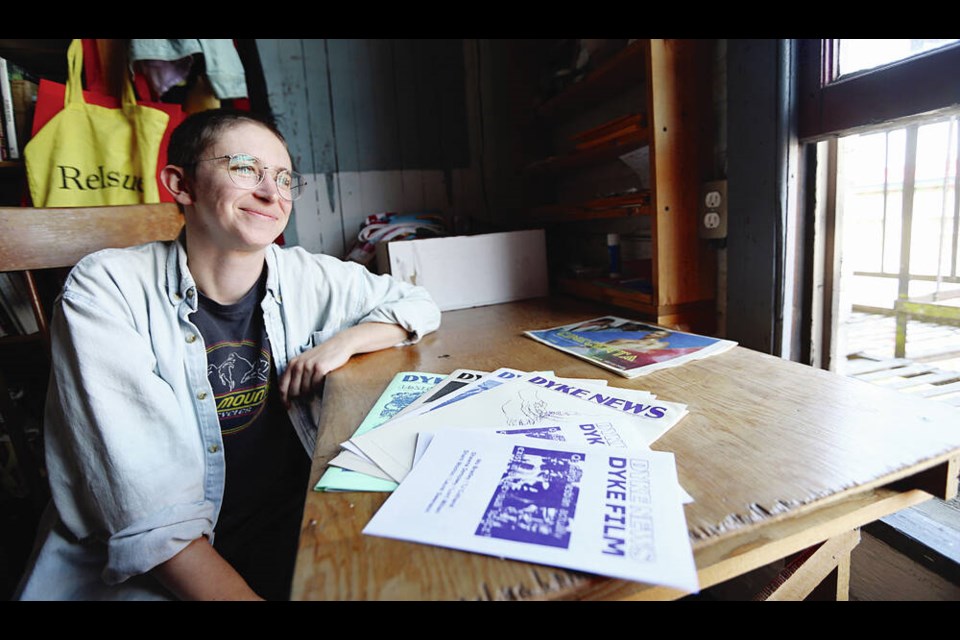While searching the University of Victoria archives last year for a queer print history project, Kara Stanton was struck by the vivid depiction of Victoria’s lesbian life they saw in newsletters.
“When I see all the ads for things that were going on in the ’90s, I’m really blown away by how much was happening,” said the 28-year-old freelance editor and writer. “There were two lesbian softball teams, there was a basketball league, there was a bowling league.”
Nowadays, much of Victoria’s queer discourse happens online on social media platforms, spaces that Stanton describes as “inherently flawed” and just “trying to eat our attention.”
“Instagram has its own algorithm, it has its own advertisers — it doesn’t have the priorities of community at its heart,” Stanton said. “There should be more ways for us to know what’s going on in each others’ lives.”
In response, Stanton decided to revive an old city tradition — a print community newsletter, written for and by lesbians.
Dyke News, which published its first edition a year ago, in May 2022, is meant to foster community space in print for everyone from lesbians to those with non-binary and transgender, non-conforming identities who have a relationship to lesbian culture, said Stanton.
“A lot of people now might be lesbians but not identify as women, or identify as dykes but be trans,” said Stanton, who uses they/them pronouns and is a self-described dyke.
Personal essays are a feature in every issue — and that’s deliberate.
“One of the main things that motivated me to start it was really just to know what was going on in my community. I wanted to know, like, what are people thinking about? What are they talking about?”
Past issues have featured frank first-person anecdotes about participating in a 1990s-era gay parade, as well as nights out in local bars and the experience of getting a tattoo, along with poetry and reviews of music and books.
The newsletter is printed on a discontinued “functional enough” Japanese risograph machine, Stanton said, adding that the annual subscription rate — from $20 to $45 for home delivery of four issues a year, depending on location and discounts — is about enough to cover the cost of stamp and paper.
It’s a largely one-person shop at Dyke News: Stanton lays out all the contributor copy and art on a laptop with the latest Adobe software, alone in a top-floor Chinatown studio space. A group of friends helps fold and write out mailing addresses over dinner every time an issue is printed.
Single issues of Dyke News can also be found at local stores such as Camas Books and Brass Iriss Studio as well as in bookstores as far away as Seattle and Edmonton.
The regular cost of an annual Dyke News subscription — $25 — is the same as for its predecessor LesbiaNews, a print newsletter that published news and views from the Victoria lesbian scene from 1989 until 1996.
“Those were the days when [it was] cut and paste and everything was physical,” said Debby Yaffe, the founding editor of LesbiaNews and retired women’s studies instructor at the University of Victoria. “We would do everything on mimeograph machines and it’d be papers all over the floor, and women would get together and we would collate and staple and address.”
Yaffe said she is happy that there are people like Stanton who are creating a sense of community for younger lesbians in Victoria.
She said a Dyke News-sponsored film night held last year was “fabulous with that kind of young, boisterous energy.” Another affiliated film screening with an accompanying picnic is set for this month at Cinecenta.
Yaffe said it’s “very important to have some kind of public presence.”
“For all the acceptance, we are still very much a minority,” she said. “I don’t take it for granted. Anything could change. Laws can change again.”
Stanton said there is a public perception that “things are always getting better for queer people, things are always getting better for trans people — but in fact I think we have a lot fewer public spaces or shared spaces than people did even two decades ago.”
As examples of Victoria’s long-gone lesbian spaces, they pointed to former establishments such as the Queen’s Head, a lesbian bar, The G Spot, a lesbian drop-in community centre and nightclub, and Everywoman’s Bookstore, a feminist bookstore collective.
Victoria’s queer community has become more wary since violent threats forced organizers to call off a drag show at Caffe Fantastico in 2022, said Stanton, adding that while there are rainbow flags all over the city right now, there seem to be fewer spaces where queer people can feel safe to hang out.
“Yes, it’s pride season and there’s a lot of gay things happening. But where’s the sustained queer space?”
>>> To comment on this article, write a letter to the editor: [email protected]



